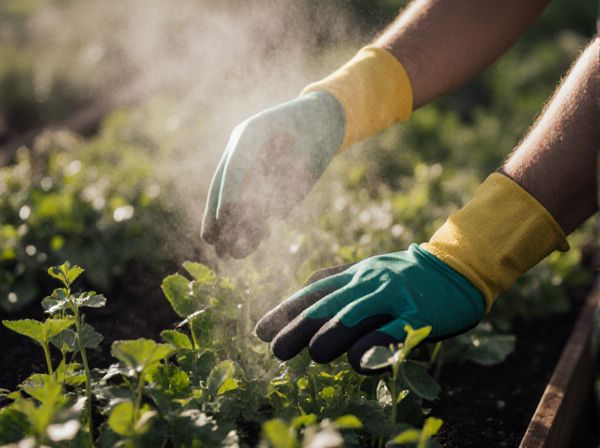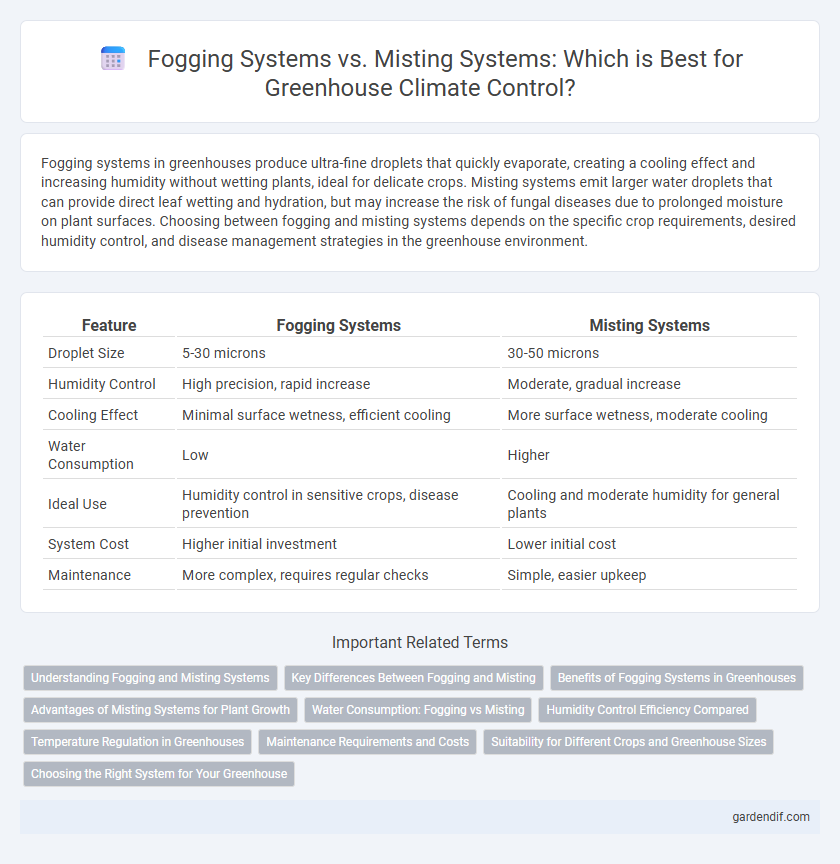
Fogging Systems vs Misting Systems Illustration
Fogging systems in greenhouses produce ultra-fine droplets that quickly evaporate, creating a cooling effect and increasing humidity without wetting plants, ideal for delicate crops. Misting systems emit larger water droplets that can provide direct leaf wetting and hydration, but may increase the risk of fungal diseases due to prolonged moisture on plant surfaces. Choosing between fogging and misting systems depends on the specific crop requirements, desired humidity control, and disease management strategies in the greenhouse environment.
Table of Comparison
| Feature | Fogging Systems | Misting Systems |
|---|---|---|
| Droplet Size | 5-30 microns | 30-50 microns |
| Humidity Control | High precision, rapid increase | Moderate, gradual increase |
| Cooling Effect | Minimal surface wetness, efficient cooling | More surface wetness, moderate cooling |
| Water Consumption | Low | Higher |
| Ideal Use | Humidity control in sensitive crops, disease prevention | Cooling and moderate humidity for general plants |
| System Cost | Higher initial investment | Lower initial cost |
| Maintenance | More complex, requires regular checks | Simple, easier upkeep |
Understanding Fogging and Misting Systems
Fogging systems in greenhouses produce ultra-fine water droplets measuring less than 10 microns to quickly increase humidity and cool the air without wetting plants, ideal for delicate crops. Misting systems emit larger droplets around 30-50 microns, providing moderate humidity and surface cooling while slightly wetting plant surfaces, which can help reduce dust and pests. Understanding the droplet size and application effects is crucial for selecting between fogging and misting systems to optimize plant health and growth conditions.
Key Differences Between Fogging and Misting
Fogging systems produce ultra-fine water droplets measuring 5-30 microns, creating a dense fog that rapidly cools and humidifies the greenhouse environment. Misting systems emit larger droplets, typically 30-50 microns, providing gentle moisture primarily for plant hydration without significantly lowering temperature. The distinct droplet size affects evaporation rates and coverage area, making fogging ideal for precise humidity control and misting suitable for delicate plant watering.
Benefits of Fogging Systems in Greenhouses
Fogging systems in greenhouses provide superior humidity control by producing ultra-fine water particles that evaporate quickly, maintaining optimal moisture levels without wetting plants or soil. These systems enhance cooling efficiency, improve plant transpiration rates, and reduce the risk of fungal diseases compared to traditional misting systems. Their precise micro-droplet size promotes better air circulation and nutrient absorption, leading to healthier and more vigorous plant growth.
Advantages of Misting Systems for Plant Growth
Misting systems enhance plant growth by providing fine water droplets that improve humidity control and reduce heat stress in greenhouses. These systems promote better foliar hydration and nutrient absorption, leading to healthier and more robust plants. Compared to fogging systems, misting delivers more targeted moisture, minimizing water waste and optimizing resource efficiency for sustainable cultivation.
Water Consumption: Fogging vs Misting
Fogging systems use ultra-fine water droplets that evaporate quickly, resulting in significantly lower water consumption compared to misting systems which emit larger droplets that settle faster. This efficient evaporation in fogging helps maintain optimal humidity with minimal water waste, crucial for greenhouse environments aiming to conserve resources. Misting systems often require higher volumes of water to achieve similar cooling and humidity effects, leading to increased operational costs and water usage.
Humidity Control Efficiency Compared
Fogging systems produce ultra-fine water particles that quickly evaporate, offering superior humidity control and uniform distribution in greenhouses compared to misting systems, which release larger droplets that can cause uneven moisture and waterlogging. Fogging enhances plant transpiration and reduces heat stress more efficiently, maintaining optimal relative humidity levels between 60-80% critical for greenhouse crops. Misting systems, while effective for cooling, often require frequent operation cycles to sustain humidity, leading to higher water usage and less precise environmental control.
Temperature Regulation in Greenhouses
Fogging systems provide finer water droplets that rapidly evaporate, effectively lowering greenhouse temperatures through increased humidity and evaporative cooling. Misting systems emit larger droplets that cool the air more gradually but also help maintain adequate moisture levels, preventing plant stress during warmer periods. Temperature regulation in greenhouses benefits from fogging systems' precision in temperature control, while misting systems contribute to consistent humidity balance.
Maintenance Requirements and Costs
Fogging systems require regular maintenance to prevent nozzle clogging and ensure proper droplet size, often involving more frequent filter replacements and cleaning compared to misting systems. Misting systems typically have lower maintenance costs due to simpler components and less susceptibility to mineral buildup, but still demand routine inspections to avoid blockages. Overall, fogging systems incur higher operational expenses, while misting systems offer a more cost-effective solution for maintaining optimal humidity in greenhouses.
Suitability for Different Crops and Greenhouse Sizes
Fogging systems provide ultra-fine droplets that create high humidity levels, making them ideal for delicate crops such as orchids and lettuce in smaller or medium-sized greenhouses. Misting systems emit larger droplets and can cover broader areas efficiently, suited for robust crops like tomatoes and cucumbers in larger greenhouse environments. Choosing between fogging and misting depends on crop sensitivity to moisture and the physical size and ventilation capacity of the greenhouse.
Choosing the Right System for Your Greenhouse
Fogging systems deliver ultra-fine water particles to maintain high humidity levels critical for delicate greenhouse plants, while misting systems produce larger droplets for rapid cooling and moderate humidity control. Selecting the right system depends on your greenhouse's plant species, climate conditions, and humidity requirements, with fogging ideal for tropical environments and misting better suited for cooling in warmer settings. Efficient control and uniform distribution of moisture in either system enhance plant growth, reduce water waste, and prevent fungal diseases by maintaining optimal microclimates.
Fogging Systems vs Misting Systems Infographic

 gardendif.com
gardendif.com